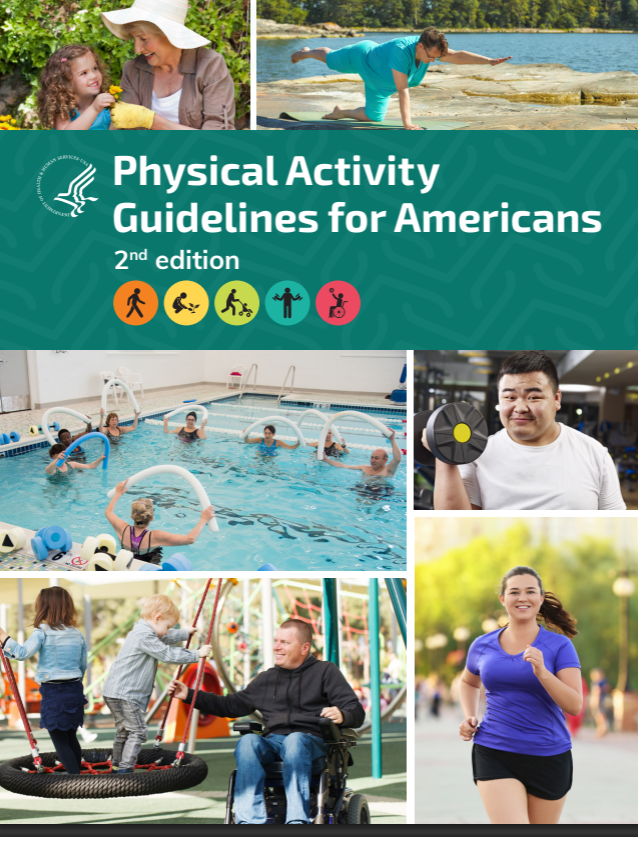
Aging Gracefully with Physical Activity
Page Navigation: Introduction l Forms of Physical Activity l Additional Resources
Engagement in regular physical activity is an essential component of maintaining health throughout our lifespan. Despite the strong research base that explains the benefits of exercise, many adults remain inactive. This page serves to help connect you with resources that may allow you to participate in enjoyable forms of physical activity.
Forms of Physical Activity to Explore
Click on an image below to jump to the corresponding section of interest
Aquatic/Pool Exercise
Yoga
Our website is also home to a collection of free YouTube videos that are appropriate for older adults. Click Here to view the collection.
Tai Chi
High-Intensity Interval Training (HIIT)
Fall Prevention Programs
Resistance Training Programs
Additional Resources
Physical Activity Guidelines
These guidelines serve as an excellent foundational reference for the topic of physical activity. Produced by the U.S. Department of Health and Human Services, the following PDF provides guidelines specific to various stages of life and physical abilities.
Local Senior Centers
Senior centers are another excellent resource for older adults. They are home to many gatherings that foster social engagement and wide-ranging resources to ensure the well-being of seniors within their communities. Investigate the resources offered by your local senior center by clicking on their respective image.
(Options listed are specific to the Shoreline of CT)
References
Stock Photo
Green Grass Field photo made by André Cook from Pexels
Prevalence of Physical Inactivity in Older Adults
Watson KB, Carlson SA, Gunn JP, et al. Physical inactivity among adults aged 50 years and older - United States, 2014.
MMWR Morb Mortal Wkly Rep. 2016; 65:954-958. [Open Access]
Consequences of Physical Inactivity
Ding D, Lawson KD, Kolbe-Alexander TL, et al. The economic burden of physical inactivity: a global analysis of major noncommunicable
diseases. Lancet. 2016; 388:1311-1324. [Access]
Lee IM, Shiroma EJ, Lobelo F, et al. Effect of physical inactivity on major non-communicable diseases worldwide: an
analysis of burden of disease and life expectancy. Lancet. 2012; 380:219-229. [Open Access]
de Souto Barreto P. Global health agenda on non-communicable diseases: has WHO set a smart goal for physical activity?
BMJ. 2015;350:h23. [Access]
Carlson SA, Adams EK, Yang Z, Fulton JE. Percentage of Deaths Associated With Inadequate Physical Activity in the United
States. Prev Chronic Dis. 2018;15:E38. [Open Access]
Sakuma K, Yamaguchi A. Sarcopenia and age-related endocrine function. International journal of endocrinology. 2012;2012. [Open Access]
Exercise Recommendations for Older Adults
Paterson DH, Jones GR, Rice CL. Ageing and physical activity: evidence to develop exercise recommendations for older
adults. Applied physiology, nutrition, and metabolism. 2007;32(S2E):S69-S108. [Open Access]
Iliffe S, Kendrick D, Morris R, et al. Multicentre cluster randomised trial comparing a community group exercise
programme and home-based exercise with usual care for people aged 65 years and over in primary care. Health
technology assessment (Winchester, England). 2014;18(49):vii. [Open Access]
Physical Activity Guidelines for Americans, 2nd edition
Produced by the U.S Department of Health and Human Services and available at HHH.gov
Aquatic Exercise
Tilden H., Reicherter A., Reicherter F. Use of an aquatics program for older adults with osteoarthritis. Topics in Geriatric Rehabilitation. 2010; 26(2): 128-139.
Bartels E., Juhl C., Christensen R., et al. Aquatic exercise for the treatment of knee and hip osteoarthritis. Cochrane Database of Systematic Reviews. 2016; 3.
Yoga
Sivaramakrishnan D., Fitzsimons C., Kelly P., et al. The effects of yoga compared to active and inactive controls on physical function and health related quality of life in older adults – systematic review and meta-analysis of randomised controlled trials. Journal of Behavioral Nutrition and Physical Activity. 2019; 16:33.
Tai Chi
Taylor-Piliae R. and Finley B. Tai Chi exercise for psychological well-being among adults with cardiovascular disease: a systematic review an meta-analysis. European Journal of Cardiovascular Nursing. 2020; 19(7): 580-591.
High-Intensity Interval Training
Keating C., Parraga M., Juan Antonio P., Latorre Roman P. Comparing high-intensity interval training to moderate-intensity continuous training in older adults: a systematic review. Journal of Aging and Physical Activity. 2020.
Dun Y., Smith J., Liu S., et al. High-intensity interval training in cardiac rehabilitation. Clinical Geriatric Medicine. 2020.
Fall Prevention Exercise
Cederbom S. & Arkkukangas M. Impact of the fall prevention Otago Exercise Programme on pain among community-dwelling older adults: a short- and long-term follow-up study. Clinical Interventions in Aging. 2019; 14: 721-726.
Resistance Training
Watson S., Weeks B., Weis L., et al. High-intensity exercise and impact training improves bone mineral density and physical function in postmenopausal women with osteopenia and osteoporosis: the LIFTMOR randomized controlled trial. Journal of Bone and Mineral Research. 2018; 33(2):211-220.















































